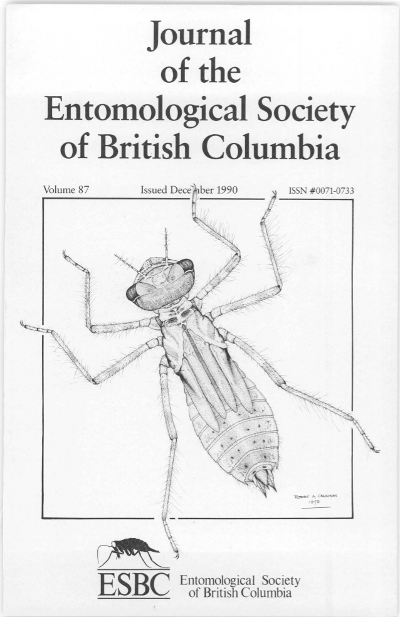Predators associated with the twospotted spider mite, <i>Tetranychus urticae</i>, on strawberry at Abbotsford, B.C., and development of non-chemical mite control
Abstract
Populations of the two spotted spider mite, Tetranychus urticae Koch on strawberry were sampled from 1983-86. The predaceous mite, Amblyseius fallacis (Garman), was predominant. Active adults were observed in February and November, earlier in the spring and later in the autumn than any other predator. Amblyseius fallacis, cecidomyiid flies of Aphidoletes sp. and the ladybird beetle, Stethorus punctum picipes Csy., all responded numerically to introductions of the twospotted mite but A. fallacis responded to the greatest degree. The rate of increase of A. fallacis on a 10& scale was 1.0335 ± 0.0621 per 100 degree-days above 4C (DD4) in the spring and summer, and 0.5481 ±0.0845 per 100 DD4 in late summer, about 2.1 x and 1.6 x per week on an arithmetic scale. Slide dip tests showed that populations of A. fallacis in the Lower Fraser Valley were resistant to the chemical compounds cyhexatin, endosulfan and malathion, partially resistant to diazinon and very susceptible to carbofuran, demeton , dicofol and dimethoate. Biocontrol of T. urticae is discussed in the context of integration with the chemical control of aphids, and predator release rates.Downloads
Issue
Section
License
Authors who publish with the Journal of the Entomological Society of British Columbia agree to the following terms:
-Authors retain copyright and grant the journal right of first publication with the work simultaneously licensed under a Creative Commons Attribution License that allows others to share the work with an acknowledgement of the work's authorship and initial publication in this journal.
-Authors are able to enter into separate, additional contractual arrangements for the non-exclusive distribution of the journal's published version of the work (e.g., post it to an institutional repository or publish it in a book), with an acknowledgement of its initial publication in this journal.
-Authors are permitted and encouraged to post their work online (e.g., in institutional repositories or on their website) prior to and during the submission process, as it can lead to productive exchanges, as well as earlier and greater citation of published work (See The Effect of Open Access).


